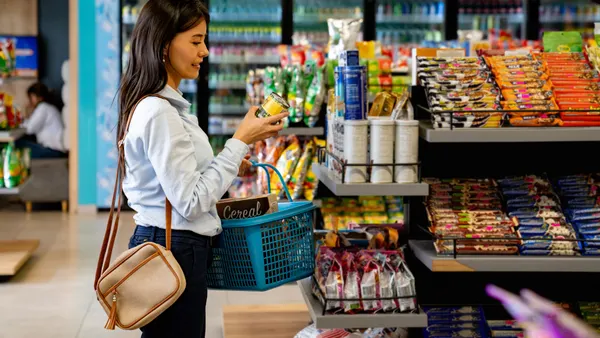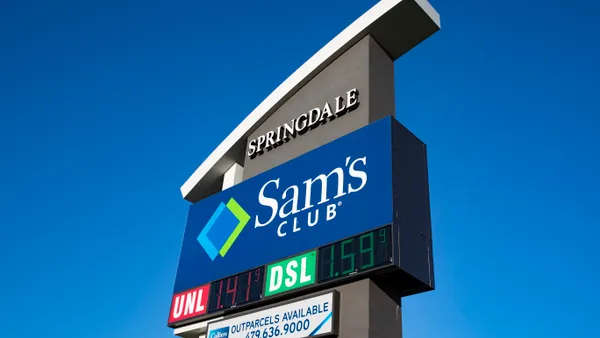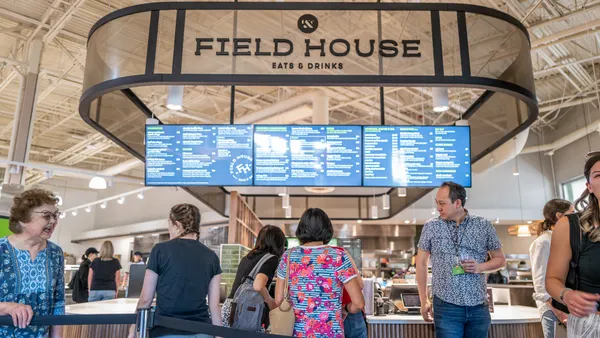Dive Brief:
- Eighty-five percent of consumers don't know what they're having for dinner until hours before mealtime, leading many to choose convenience foods from a restaurant, meal kit or grocery deli, according to a survey from Acosta and Technomic reported by Food Navigator. The survey found millennials are more likely to buy prepared foods from the grocery store or a restaurant, but Generation Z is likely to outspend them in these channels.
- The survey found food delivery services such as GrubHub and UberEats are increasingly popular with younger consumers, with 44% of millennials reporting using them in the past three months, compared with one in five of all U.S. consumers. Nearly 20% said they used meal kits in 2017, compared with 8% two years earlier.
- Health is still important for consumers. More than half of millennial diners and those with families told Acosta and Technomic they look for healthier options when ordering from restaurant or delivery menus — meals with fish and organic ingredients, or for vegetarian items made with local ingredients, the report says. On the other hand, younger consumers will indulge. Nearly a third expressed interest in burgers, while 27% wanted chicken wings, 21% were hungry for Mexican foods, 14% would buy barbecue and 11% looked at desserts, according to the survey.
Dive Insight:
Today’s consumers are hungry for convenience when it comes time to put dinner on the table. The Acosta report found millennial diners spend $513 a month on food, with 40% spending on food outside the home. In contrast, Generation X consumers spend about $469 a month on food, with almost a third of that for food prepared elsewhere. Those numbers could spell trouble for packaged food companies that don’t adapt to today’s call for easy meal prep.
Some CPG companies — Nestlé's Lean Cuisine, Pinnacle Foods' Birds Eye and Gardein brands and B&G Foods' Green Giant among them — have been innovating with an eye on appealing to last-minute consumers, introducing one-bowl meals, larger entrées and more spicy and flavorful items.
Conagra's Banquet brand, which CEO Sean Connolly told Food Dive had "packaging that looked like it was from the '80s," was refreshed. A new premium "mega" tier for people with big appetites — especially targeting the millennial crowd — was added. The company also introduced cheeseburger and hot chicken sliders to cater to the on-the-go consumers craving protein. The strategy paid off, with Banquet sales jumping 6% from the prior year.
CPG companies aren’t the only ones struggling to find a fit in today’s new world. Although two-thirds of Americans don’t know what’s for dinner by 4 p.m., grocery foodservice — which seems like the perfect fit — does not often come to mind, according to the Food Marketing Institute's "The Power of Foodservice at Retail 2018 Part 2" report. Out of the third of consumers who typically know what will be on the dinner table, only 15% tend to think of prepared food at the grocery store on days they have not planned dinner.
This study also found the less likely shoppers are to have set dinner plans, the less they tend to spend per person in grocery stores. Weekly meal plans, chef's specials and online planning or shopping tools could help connect consumers to grocer foodservice offerings, FMI says.
To stay relevant, CPG food companies could promote the ease and healthiness of their products, as well as aggressively market this aspect both in traditional grocery stores and online. With Gen Zers moving toward buying prepared foods outside the home at an even faster pace than millennials, food companies don't have time to waste.










